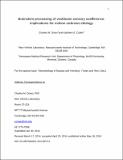Brainstem processing of vestibular sensory exafference: implications for motion sickness etiology
Author(s)
Oman, Charles; Cullen, Kathleen
DownloadOman Cullen Brainstem processing exafference manuscript 2014 (616.3Kb)
Metadata
Show full item recordAbstract
The origin of the internal “sensory conflict” stimulus causing motion sickness has been debated for more than four decades. Recent studies show a subclass of neurons in the vestibular nuclei and deep cerebellar nuclei that respond preferentially to passive head movements. During active movement, the semicircular canal and otolith input (“reafference”) to these neurons is cancelled by a mechanism comparing the expected consequences of self-generated movement (estimated with an internal model- presumably located in the cerebellum) with the actual sensory feedback. The un-cancelled component (“exafference”) resulting from passive movement normally helps compensate for unexpected postural disturbances. Notably, the existence of such vestibular “sensory conflict” neurons had been postulated as early as 1982, but their existence and putative role in posture control, motion sickness has been long debated. Here we review the development of “sensory conflict” theories in relation to recent evidence for brainstem and cerebellar reafference cancellation, and identify some open research questions. We propose that conditions producing persistent activity of these neurons, or their targets, stimulates nearby brainstem emetic centers – via an as yet unidentified mechanism. We discuss how such a mechanism is consistent with the notable difference in motion sickness susceptibility of drivers as opposed to passengers, human immunity to normal self-generated movement, and why head restraint or lying horizontal confers relative immunity. Finally, we propose that fuller characterization of these mechanisms, and their potential role in motion sickness could lead to more effective, scientifically based prevention and treatment for motion sickness.
Description
Penultimate version of manuscript accepted 4/20/14, and after minor edits, published online May 18, 2014 at Springer Online First as DOI 10.1007/s00221-014-3973-2
Date issued
2014-04-20Publisher
Springer
Citation
DOI 10.1007/s00221-014-3973-2
Other identifiers
DOI 10.1007/s00221-014-3973-2
Keywords
Motion sickness, brainstem, cerebellum, sensory conflict, nausea, vomiting